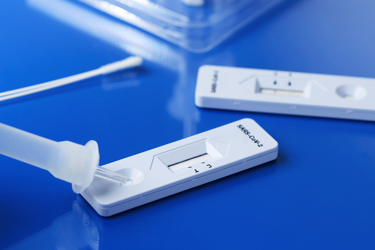5 Key Factors To Gain Regulatory Approvals for Innovative Rapid Diagnostic Devices
By Valerie Phillips, PA Consulting; and Ben Jacoby, Cambridge RA Ltd.

COVID-19 demonstrated the power of rapid diagnostics on a global scale. FIND reported that 6.5 billion COVID tests have been performed since the beginning of the pandemic. In the aftermath of the pandemic, players across the ecosystem, including medtech innovators, established global in vitro diagnostic (IVD) developers, academics, and healthcare payers and providers, are committed to finding other areas where rapid diagnostics can be effectively deployed. All recognize that rapid diagnostics can be deployed for a wide range of indications to meet some of the challenges of healthcare delivery today.
Consequently, strong growth is anticipated in both point of care testing and direct to consumer testing, which includes a consumer self-collecting a sample, which is then processed remotely, or a consumer undertaking and completing the test themselves. The point of care testing market is estimated to grow at a CAGR of 7.9% to $71 billion by 2030, while the at-home testing market is forecast to grow at a CAGR of 10.5% to $45.6 billion by 2031.
Growth in rapid diagnostics is influenced by the deployment of new care models, such as virtual care wards and hospital at home schemes, as well as a shift toward self-care. In the U.S., the number of Centers for Medicare and Medicaid Services (CMS)-approved hospitals offering hospital at home care has increased by 118% since April 2021. In the U.K., the government increased its coverage of virtual wards to 50,000 patients a month in January 2023, up from 10,000. Creating value from this shift to home care is explored in our recently published Healthier at Home report.
A range of complex challenges need to be overcome to realize the market opportunity for rapid diagnostics, especially in the regulatory space. Gaining regulatory approval is imperative for market access, yet navigating the regulatory landscape is becoming increasingly complex: regulators are bringing in new regulations and the system is finding it difficult to play catch-up, leading to huge capacity problems. Moreover, gaining regulatory approval is a lengthy and often expensive process. How can IVD developers and medtech leaders successfully navigate this complex territory and gain market access for the benefit of the healthcare systems and patients? We outline five key factors for leaders to consider enabling efficient, smooth regulatory approval pathways.
1. Obtain Deep Market Understanding To Inform “Value”
COVID-19 was a worldwide problem, across all demographics and use cases. Going forward, use of rapid tests will be deployed in a highly segmented manner across multiple use cases, diseases, user groups, and settings. IVD developers are likely to be influenced by the frequency of testing across use cases, which in turn can determine manufacturing volumes and, ultimately, sales. When considering a wider range of indications, it is key for developers to understand the actual problem their solution will address and who will benefit from their proposed solutions.
A rapid test can provide a clinical benefit in a situation where time is key. For example, a troponin test can rule in/out a “silent” heart attack in an emergency, while a rapid test such as flu testing can support triage in a specific setting and enable infection control. Rapid testing also enables patient self-monitoring for long-term chronic conditions and may reduce the requirement for in-person clinical visits, thereby saving time for both patients and healthcare professionals, as well as providing an enhanced, more convenient testing experience. An example is regular cholesterol monitoring.
It is imperative that IVD developers gain a deep market understanding of the health conditions, current pathways, current testing technologies in use, pain points in the current practices, and value their solutions can provide to understand “value” and ensure market acceptance.
2. Recognize The Regulator’s Point Of View And Collaborate With The Regulator
Innovations in the rapid diagnostics space are introducing new challenges for regulators, who now need to consider new complexities, such as lack of predicates, visual rather than quantitative results, calibration and quality assurance of test results, tests being performed by lay users and healthcare professionals with less experience with diagnostic testing, tests being used in non-clinical settings, and digital uploads of results. The regulators’ key concerns are for patient safety and when it comes to rapid diagnostics, they will have a keen eye on clinical and usability evidence, impact of specific test settings, the qualification and training of users, and methods for results reading and results recording. It is key that IVD developers gain an in-depth understanding of the regulators’ concerns and work with the regulators to establish pathways and agree on an evidence basis that is acceptable.
Regulators are under pressure themselves to innovate their practices to support innovation pathways and ensure that, ultimately, patients can benefit from industry innovations. In response, the regulators are launching consultations to obtain external stakeholder input and are bringing in new initiatives to respond to the pace of innovation. For example, in the U.S., the FDA has launched the Breakthrough Devices Program, which offers feedback to the developer during the development of the device and offers prioritized submission review, once the device qualifies for the program. The FDA has also announced a public consultation on Increasing Patient Access to At-Home Use Medical Technologies, stating that “access to devices outside a clinical care setting may help bridge the gap by bringing health care directly to patients, wherever they are – at home, at work, in cities, in rural communities. The effort to expand access to home use technologies is consistent with the FDA’s strategic aim focused on advancing health equity.”
In the U.K., the MHRA (the Medicines and Health products Regulatory Agency), has announced a new Innovative Devices Access Pathway, iDAP, combining regulation and technology assessment that aims to take uncertainty out of the route to access, thereby bringing innovative technologies to patients that can transform health outcomes.
We expect to see a higher degree of collaboration between global regulatory bodies and external stakeholders such as health technology assessors, IVD developers, clinicians, academics, and patients, all of whom will work together to develop innovative approaches for regulatory pathways.
3. Design User-Centric Solutions To Reduce Or Eliminate Risk Where Possible
Many rapid diagnostic solutions have been designed for use by medically trained professionals and in traditional clinical settings. By moving these tests into alternate settings, including community testing hubs, retail settings, care homes, schools, and other home settings, there is a higher risk of use error.
Frequency of testing plays a significant role in user behaviour and accuracy of testing. For example, tests that are performed daily can become routine and repetition may encourage proficiency. On the other hand, specific tailored instructions may need to be designed appropriately for tests that are undertaken infrequently or on a one-off basis.
Instructions for use are not always user-friendly. There is an opportunity for IVD developers to design testing solutions that reduce and mitigate these risks, including reducing the number of components, reducing the number of testing steps, designing tests that incorporate a range of sample types (beyond blood), designing for use in specific non-clinical settings, improving packaging and handling steps, providing improved reading and recording of results, including via digital solutions, and providing user-friendly, easy to follow instructions for laypersons. As we mentioned in point 2, user-centric design will support regulatory submissions by allaying regulators’ concerns for patient safety in new settings. However, this places a demand on IVD developers to develop world-class capabilities in user-centric design and human factors engineering.
4. Enable Integrated Clinical Decision-Making Where Required
Where applicable, rapid diagnostic tests can be digitally connected to the wider health system to ensure appropriate clinical decision-making is enabled. For example, an end user suffering from a long-term chronic condition may have a requirement to self-test for a specific analyte on a regular basis. It may be important to the caregiver to have visibility of testing frequency and outcomes to enable optimal clinical decision-making. Given the heterogeneity of established digital systems in primary and secondary care, this poses a huge challenge to IVD developers. This is another capability that IVD developers will need to develop. Creating yet another proprietary result recording tool such as a dedicated electronic device will not always add value for the end user and care provider. Utilizing ubiquitous consumer devices, such as iPads and smartphones, rather than dedicated devices, can be convenient and therefore more likely to encourage adoption and scalability. On the other hand, the use of personal devices to carry out tasks such as recording, analyzing, storing, and transmitting patient results may not always be accepted by healthcare systems.
5. Undertake A Health Technology Assessment To Evidence Value And Support Adoption
In instances where rapid diagnostic solutions are intended to be used as part of the healthcare system, health technology assessments (HTAs) are valuable tools in evidencing value and supporting adoption of novel testing technologies and new uses of existing technologies. The main purpose of HTAs is to provide policymakers with evidence-based information, so they can formulate health policies that are safe, effective, patient-focused, and cost-effective. They are also used by national authorities to help make decisions on which technology should be reimbursed at national levels. HTAs form a critical component of reimbursement pathways.
Recently, there has been a renewed focus on HTAs. For example, a new European regulation will apply from January 2025 that supersedes the current system of EU-funded project-based cooperation between Member States on health technology assessments. It introduces a permanent framework for joint work that will also cover joint scientific consultations, the identification of emerging health technologies, and voluntary cooperation, as well as work on joint clinical assessments. In the U.K., NICE recently established partnerships with five other global HTA bodies from three continents to collaborate on a range of topics that will benefit people accessing healthcare around the world. These partners will work together on shared priorities to identify solutions to some of the common challenges. Their priorities include future proofing HTA systems, collaborating with regulators, and potentially using each other’s HTA information and exploring pilots for joint clinical assessments.
Conclusion
While strong growth is widely anticipated in the uptake of rapid diagnostics, we anticipate there are several barriers to overcome to ensure successful rollout and widespread adoption. To overcome these, there will need to be participation by several players across the ecosystem and, in particular, close working relationship with regulatory bodies to design approval pathways with clear requirements for risk mitigation and evidence basis to ensure approval. This will require a fresh approach to product design and development as well as new content built into technical files and regulatory submissions. Critically, rapid diagnostic manufacturers will need to build partnerships and acquire new capabilities to underpin this fresh approach to market approval.
Given the anticipated size of the prize, we anticipate a high level of competition, some innovative collaborations, and some new entrants establishing a share in this dynamic market sector.
About The Authors:
 Valerie Phillips is a medtech innovation commercialization expert at PA Consulting. She works with innovators to bring new solutions to market that focus on unmet needs, to improve patient outcomes, and meet the challenges in healthcare delivery.
Valerie Phillips is a medtech innovation commercialization expert at PA Consulting. She works with innovators to bring new solutions to market that focus on unmet needs, to improve patient outcomes, and meet the challenges in healthcare delivery.
 Ben Jacoby is the director of Cambridge RA Ltd. He is an experienced regulatory consultant who works with clients in the diagnostic, medical device, and pharmaceutical industries to help them bring innovative products to market. He provides regulatory and strategic guidance to clients on EU, U.K., and U.S. issues.
Ben Jacoby is the director of Cambridge RA Ltd. He is an experienced regulatory consultant who works with clients in the diagnostic, medical device, and pharmaceutical industries to help them bring innovative products to market. He provides regulatory and strategic guidance to clients on EU, U.K., and U.S. issues.
